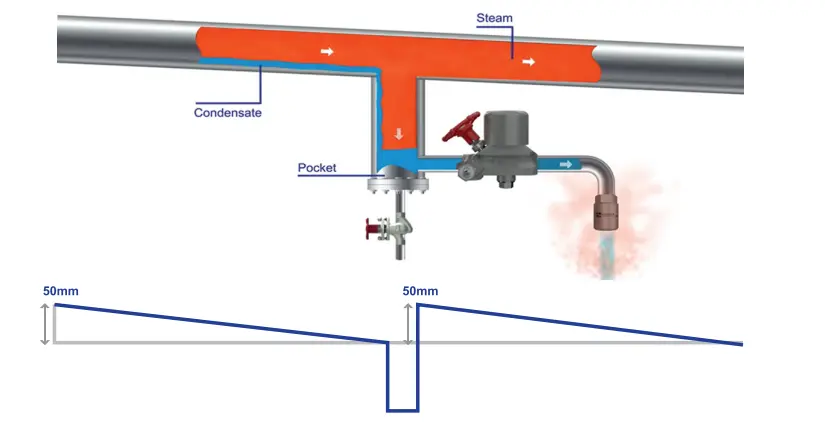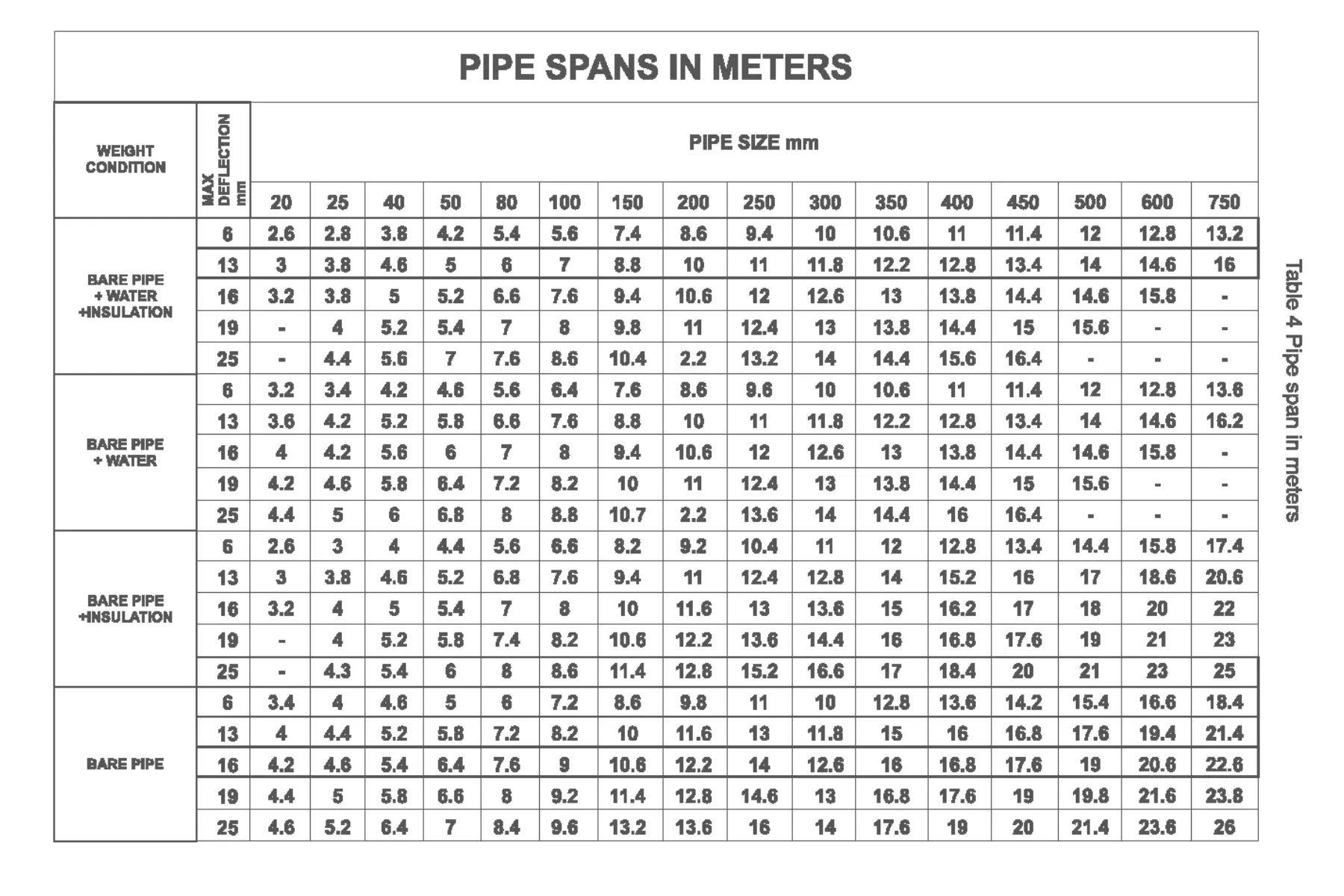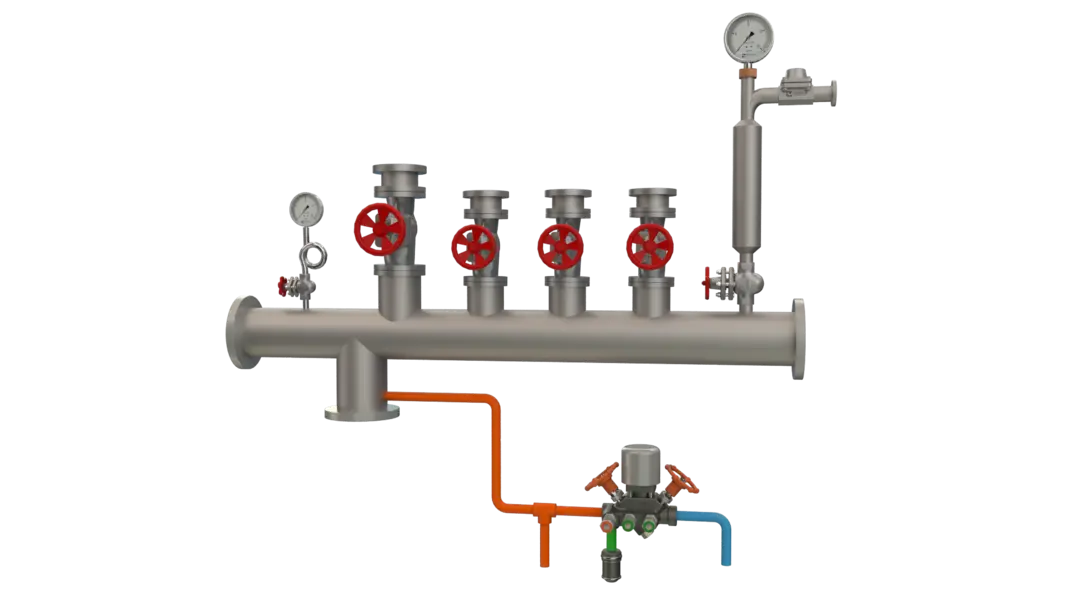How to ensure steam supplied to the process is dry
For indirect heat transfer processes, where steam is used as the heating medium, the required quantity of heat is imparted by the latent heat. Since wet steam has lower latent heat, the steam quantity required for the given rate of heat transfer increases. Additionally, moisture in the steam also impedes heat transfer efficiency and impacts the process output (poor productivity and product quality).
Thus, one of the main objectives of a good steam distribution system should be to deliver dry steam to the process. This can be achieved by taking measures to avoid condensate accumulation in the pipelines and reducing the quantum of condensation within the distribution network.
Taking measures to avoid condensate accumulation in the steam distribution network
-
Provide a slope for steam pipelines in the direction of steam flow
Steam lines/ mains should be engineered to have a slope of about 2-3 millimeters per meter to facilitate flow of condensate by gravity to the steam trap.
Illustration: Providing a slope for steam pipelines

-
Provide adequately sized drain pockets to capture condensate formed in the pipelines
Steam flowing in the pipelines at a speed of about 25 meters/second (90 kilometers/ hour) will carry condensate present in the pipelines at similar speeds. Although a 15- 20 millimeter drain pipe has sufficient flow capacity, it is unable to capture much of the condensate which is moving along the pipelines at high speed. This leads to condensate accumulation within the lines resulting in water hammer or wet steam.
Illustration: Sizing of drain pockets

Correctly sized drain pockets should be provided to capture condensate formed in the lines so that it can reach the steam trap and be effectively evacuated.
Read more: Guidelines to size drain pockets
-
Provide steam traps to evacuate condensate from the steam pipelines
Steam constantly loses heat due to radiation and continuously condenses along the entire length of the distribution network. This condensate needs to be evacuated by installing thermodynamic steam traps along the length of the steam distribution network.
Read more on where should steam traps be installed in the distribution network
-
Prevent sagging of steam lines
Recommended support span must be followed when installing steam pipelines to avoid sagging. Sagging typically occurs either due to inadequate supports or failure of supports leading to condensate accumulation in the pipelines at the point of sag.
Video: Prevent sagging of steam lines
Accumulated condensate leads to wet steam and water hammer. The recommended support span for steam pipelines is as follows:

-
Select and install pipeline fittings / accessories correctly
Select and install pipeline fittings like reducers and strainers correctly to avoid accumulation of water. For example, for horizontal steam lines, always use eccentric reducers instead of concentric reducers. Concentric reducers being symmetrical in shape, lead to a change in elevation of the piping system. In contrast, eccentric reducers have an off-centre or eccentric shape, which allows for the reduction in pipe size without affecting the elevation of the piping.
Maintaining the elevation of the pipeline ensures that condensate build-up in the low points of the piping system, which is a a major cause of wet steam and water hammer, does not occur.
Video: Selection and installation of pipeline reducers
Similarly strainers should always be installed correctly to avoid condensate build-up due to debris accumulation.
Video: Strainer installation
-
Install startup traps in the steam distribution system
Situations may arise when steam supply to either the whole plant or certain sections/ production blocks is shut off. In such cases, the distribution piping can cool down to ambient temperatures (depending on the duration for which steam is shut-off). When steam is once again admitted to such pipe lines, it will rapidly condense.
It is imperative to evacuate this condensate from the pipelines quickly to avoid water hammer. Condensate logging in the steam pipelines will also prolong start up time as it will take longer for the pipelines to attain the operating temperature.
Typically, during startup, many plants resort to manually opening the steam trap bypass valves. If plant personnel inadvertently miss opening the bypass valves it can result in damage to the pipeline or pipeline accessories. Consequently, if they forget to shut off the bypass valves it can lead to significant loss of steam.
Startup traps are devices that automate this process, eliminating dependence on manual intervention to open / close bypass valves during startup.
Illustration: Start-up trap

Startup traps operate on the thermostatic principle. When the steam supply is shut-off the residual condensate in the pipeline becomes sub-cooled. At this time the startup traps open and release the condensate. When the pipelines are once again charged with steam, the startup trap evacuates condensate, until the condensate temperature reaches 90°C. Once the condensate temperature exceeds 90C, the startup trap automatically closes.
-
Install moisture separators
Wet steam is steam containing suspended water droplets / entrained moisture, and is a concern as it reduces plant productivity and product quality, increases energy consumption and causes damage to equipment and pipeline accessories.
While strategically located drain pockets and steam traps will remove condensate formed in the steam pipelines, they will not remove water droplets suspended in the steam. To remove these suspended water droplets, moisture separators are installed in the steam pipelines.
The moisture separator consists of baffles. Moisture entrained in steam collides with these baffles, and due to drop in velocity, gets separated from the steam and needs to be evacuated using a thermodynamic steam trap.
Read more: Where should moisture separators be installed in a steam distribution network
-
Take all steam tappings / connections from the top
Any steam tapping or connection to the steam line should always be taken from the top of the steam pipelines. When connections are taken from the side or the bottom, condensate and dirt/debris present in the line will be carried along through the pipelines, resulting in wet and dirty steam reaching the process equipment.
